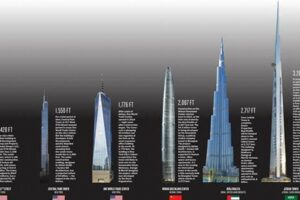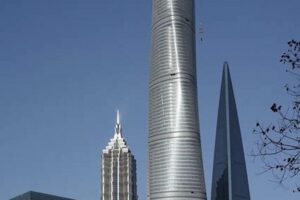Toronto, a thriving metropolis renowned for its multicultural heritage and architectural wonders, boasts the esteemed title of housing the tallest skyscraper in Canada. The CN Tower, an iconic landmark that has graced the Toronto skyline since 1976, stands as a testament to human ingenuity and architectural prowess.
Soaring to a staggering height of 553.3 meters (1,815.3 feet), the CN Tower has held the distinction of being the world’s tallest free-standing structure for over 30 years. Its groundbreaking design and innovative engineering have made it a marvel of modern architecture and a symbol of Canadian pride. The tower’s observation deck, located at a breathtaking 447 meters (1,465 feet) above the ground, offers unparalleled panoramic views of the city and its picturesque surroundings.
Beyond its architectural significance, the CN Tower serves as a crucial telecommunications hub for Toronto and the surrounding region. Its powerful transmitters broadcast radio and television signals across vast distances, ensuring reliable communication and entertainment for millions of people. Moreover, the tower’s revolving restaurant, aptly named “360 The Restaurant at the Top,” provides a unique and unforgettable dining experience, allowing guests to savor delectable cuisine while taking in the mesmerizing city views.
1. Height
The height of the CN Tower, standing at an impressive 553.3 meters (1,815.3 feet), is a defining characteristic that contributes to its title as the tallest skyscraper in Toronto and one of the tallest freestanding structures worldwide. This exceptional height has several significant implications:
Firstly, the CN Tower’s height allows it to serve as an exceptional telecommunications hub for Toronto and the surrounding region. Its powerful transmitters, situated at the tower’s peak, can broadcast radio and television signals across vast distances, ensuring reliable communication and entertainment for millions of people. The tower’s unmatched height provides a distinct advantage in signal transmission, enabling it to reach a wider area and penetrate obstacles that might hinder signals from shorter structures.
Secondly, the tower’s height has transformed it into a renowned tourist destination and a symbol of Canadian pride. Its observation deck, located at a breathtaking 447 meters (1,465 feet) above the ground, offers unparalleled panoramic views of the city and its picturesque surroundings. Visitors can take in the stunning cityscape, sprawling landscapes, and glistening waters of Lake Ontario from this vantage point, making the CN Tower a must-visit attraction for tourists and locals alike.
Furthermore, the CN Tower’s height has played a crucial role in scientific research and meteorological observations. Its elevation provides scientists with a unique platform to study weather patterns, atmospheric conditions, and environmental changes. Data collected from the tower’s observation deck and meteorological instruments has contributed to advancements in weather forecasting, climate modeling, and air quality monitoring.
In conclusion, the height of 553.3 meters (1,815.3 feet) is not merely a numerical value but a defining attribute that underpins the CN Tower’s significance as the tallest skyscraper in Toronto. Its height empowers the tower to fulfill its roles as a telecommunications hub, a tourist attraction, and a platform for scientific research, making it an iconic landmark and a vital part of the city’s infrastructure.
2. Location
The location of the CN Tower in Toronto, Ontario, Canada, is not merely a geographical coincidence but a strategic choice that has significantly contributed to its status as the tallest skyscraper in Toronto.
Toronto, as a thriving metropolis and economic hub within Canada, presents several advantages for a structure of such magnitude and purpose. The city’s robust infrastructure, including its transportation network and utilities, provides the necessary support for the tower’s operations and maintenance. Toronto’s position as a global center for business, finance, and tourism also ensures a steady stream of visitors eager to experience the tower’s attractions, including its observation deck and revolving restaurant.
Moreover, Toronto’s geographical location on the shores of Lake Ontario has played a crucial role in the tower’s telecommunications capabilities. The CN Tower’s height and proximity to the lake allow its powerful transmitters to broadcast signals over vast distances, reaching a wide audience across the region. This strategic placement has solidified the tower’s position as a vital hub for telecommunications in Canada.
In summary, the location of the CN Tower in Toronto, Ontario, Canada, is not merely an incidental factor but a carefully considered choice that has enabled the tower to fulfill its various functions effectively. The city’s infrastructure, economic significance, and geographical advantages have all contributed to the tower’s success as the tallest skyscraper in Toronto and a prominent landmark in Canada.
3. Year completed
The year 1976 marks a significant milestone in the history of Toronto’s architectural landscape, as it witnessed the completion of the CN Tower, which has since become synonymous with the city’s skyline and earned the title of the tallest skyscraper in Toronto. The tower’s construction, spanning several years, culminated in 1976 with its grand opening, forever altering the cityscape and establishing a new benchmark for architectural achievements in Canada.
The completion of the CN Tower in 1976 was not merely a construction feat but a testament to human ingenuity and engineering prowess. At the time of its completion, the tower stood as the tallest freestanding structure in the world, a title it held for over three decades. Its innovative design, incorporating a concrete core and a steel antenna, pushed the boundaries of architectural engineering and set new standards for high-rise construction. The tower’s structural integrity and ability to withstand strong winds and seismic activity have made it a marvel of modern architecture, ensuring its enduring legacy as a symbol of Canadian pride and innovation.
The completion of the CN Tower in 1976 also had a profound impact on Toronto’s tourism industry. The tower quickly became a popular destination for both domestic and international visitors, eager to experience its breathtaking views and unique attractions. The observation deck, situated at a staggering height of 447 meters (1,465 feet) above the ground, offers unparalleled panoramic vistas of the city and its surroundings, making it a must-visit attraction for tourists. The revolving restaurant, aptly named “360 The Restaurant at the Top,” provides a one-of-a-kind dining experience, allowing guests to savor delectable cuisine while taking in the mesmerizing city views.
In conclusion, the year 1976 holds immense significance in the context of “tallest skyscraper toronto,” as it marks the completion of the CN Tower, an architectural marvel that has redefined the city’s skyline and become a symbol of Canadian ingenuity and architectural prowess. The tower’s completion has not only transformed Toronto’s cityscape but has also spurred economic growth through tourism and solidified the city’s position as a global destination. Understanding the connection between “Year completed: 1976” and “tallest skyscraper toronto” provides valuable insights into the historical, architectural, and economic significance of this iconic landmark, which continues to captivate visitors and inspire generations.
4. Architect
The connection between “Architect: John Andrews” and “tallest skyscraper toronto” is significant, as John Andrews played a pivotal role in the design and construction of the CN Tower, which holds the distinction of being the tallest skyscraper in Toronto. Andrews’ vision, creativity, and expertise were instrumental in shaping the tower’s iconic design and ensuring its structural integrity, making it a symbol of Canadian architectural prowess.
John Andrews, renowned for his modernist architectural style, was selected as the lead architect for the CN Tower project in 1972. His design for the tower incorporated a concrete core and a steel antenna, a combination that allowed the structure to withstand strong winds and seismic activity. The tower’s unique shape, resembling an inverted cone, was not only aesthetically pleasing but also served a functional purpose, reducing wind resistance and providing stability. Andrews’ innovative design pushed the boundaries of architectural engineering and set new standards for high-rise construction.
The practical significance of understanding the connection between “Architect: John Andrews” and “tallest skyscraper toronto” lies in appreciating the role of architects in shaping the built environment and creating structures that are both functional and aesthetically pleasing. John Andrews’ contribution to the CN Tower showcases the importance of collaboration between architects, engineers, and builders in realizing ambitious architectural projects. His legacy as the architect of the tallest skyscraper in Toronto serves as an inspiration for future generations of architects and engineers, demonstrating the power of innovation and the pursuit of excellence in the field of architecture.
5. Structural engineer
The connection between “Structural engineer: Fazlur Khan” and “tallest skyscraper toronto” is significant, as Fazlur Khan played a pivotal role in the structural design and engineering of the CN Tower, which holds the title of the tallest skyscraper in Toronto. Khan’s innovative engineering concepts and solutions were crucial in ensuring the stability and integrity of the tower, making it a remarkable feat of architectural engineering.
Fazlur Khan, a renowned structural engineer from Bangladesh, joined the project team for the CN Tower in 1970. He introduced several groundbreaking concepts to the tower’s design, including the use of a concrete core and a steel antenna, which provided the structure with exceptional strength and flexibility. Khan’s innovative “bundled tube” design concept, where the tower’s exterior walls act as structural elements, further enhanced the tower’s ability to withstand strong winds and seismic forces.
The practical significance of understanding the connection between “Structural engineer: Fazlur Khan” and “tallest skyscraper toronto” lies in appreciating the crucial role of structural engineers in the construction of high-rise buildings and other complex structures. Fazlur Khan’s contributions to the CN Tower exemplify the importance of innovative engineering solutions in pushing the boundaries of architectural design and construction. His legacy as the structural engineer of the tallest skyscraper in Toronto serves as an inspiration for future generations of engineers, demonstrating the power of creativity and analytical thinking in the field of structural engineering.
6. Observation deck
The observation deck of the CN Tower, perched at an astounding height of 447 meters (1,465 feet) above the ground, is an integral part of the “tallest skyscraper toronto” experience. This elevated vantage point offers breathtaking panoramic views of the city and its surroundings, making it a popular tourist destination and a symbol of Toronto’s architectural prowess.
- Unparalleled Views: The observation deck provides visitors with unobstructed, 360-degree views of Toronto and beyond. From this vantage point, one can admire the city’s iconic landmarks, sprawling cityscape, glistening waterfront, and the vast expanse of Lake Ontario.
Tourist Destination: The observation deck has become a must-visit attraction for both domestic and international tourists. It offers a unique and unforgettable experience, allowing visitors to capture stunning photographs and create lasting memories of their time in Toronto.Architectural Marvel: The observation deck itself is an architectural marvel, designed to withstand the strong winds and dynamic forces acting on the tower. Its transparent glass windows and open-air platforms provide visitors with a thrilling and immersive experience.Symbol of Toronto: The observation deck has become synonymous with Toronto’s skyline and is often featured in postcards, travel brochures, and promotional materials. It serves as a beacon of the city’s architectural achievements and a testament to its modern and vibrant character.
In conclusion, the observation deck of the CN Tower, standing at 447 meters (1,465 feet) above the ground, is a key component of the “tallest skyscraper toronto” experience. It offers unparalleled views, attracts tourists from around the world, showcases architectural innovation, and has become a symbol of Toronto’s urban landscape.
7. Revolving restaurant
The connection between “Revolving restaurant: 360 The Restaurant at the Top” and “tallest skyscraper toronto” lies in the unique dining experience offered within the architectural marvel of the CN Tower. Situated at a breathtaking height of 447 meters (1,465 feet) above the ground, 360 The Restaurant at the Top provides patrons with an unforgettable culinary journey, complemented by unparalleled panoramic views of Toronto and its surroundings.
As a component of the tallest skyscraper in Toronto, 360 The Restaurant at the Top offers a dining experience unlike any other. Guests can savor delectable cuisine while taking in the ever-changing cityscape, sprawling waterfront, and distant landmarks. The restaurant’s unique revolving design allows diners to enjoy a 360-degree perspective, ensuring that every seat offers a captivating vista.
The practical significance of understanding the connection between “Revolving restaurant: 360 The Restaurant at the Top” and “tallest skyscraper toronto” extends beyond the culinary experience. This unique dining destination has become a symbol of Toronto’s architectural prowess and a must-visit attraction for tourists and locals alike. Its presence within the tallest skyscraper adds to the tower’s allure, making it a comprehensive tourist destination that caters to diverse interests.
In conclusion, 360 The Restaurant at the Top is not merely a restaurant but an integral part of the tallest skyscraper in Toronto. Its revolving design and exceptional height offer a dining experience that is both exquisite and awe-inspiring. Understanding this connection provides valuable insights into the multifaceted nature of the CN Tower, showcasing its architectural significance, culinary offerings, and its position as a global tourist destination.
8. Telecommunications hub
The connection between “Telecommunications hub: Broadcasts radio and television signals across vast distances” and “tallest skyscraper toronto” is significant, as the CN Tower’s exceptional height and strategic location make it an ideal platform for broadcasting signals over a wide area. Its role as a telecommunications hub is crucial to the city’s infrastructure and the daily lives of its residents.
The CN Tower’s height of 553.3 meters (1,815.3 feet) provides a significant advantage for telecommunications. The higher the antenna, the greater the range and coverage of the signals it can transmit. The tower’s location in the heart of Toronto, surrounded by a densely populated urban area, further enhances its ability to reach a vast audience.
The CN Tower houses powerful transmitters that broadcast radio and television signals across vast distances, ensuring reliable communication and entertainment for millions of people in Toronto and beyond. These signals reach not only the city’s core but also extend to neighboring regions, providing access to information, news, and entertainment to a wide range of communities.
The practical significance of understanding the connection between “Telecommunications hub: Broadcasts radio and television signals across vast distances” and “tallest skyscraper toronto” lies in recognizing the essential role that the CN Tower plays in Toronto’s telecommunications infrastructure. Its height and strategic location make it a vital hub for broadcasting, ensuring the smooth flow of information and entertainment to homes and businesses throughout the region.
In conclusion, the CN Tower’s status as the tallest skyscraper in Toronto is not merely a matter of architectural grandeur but also has significant practical implications. Its role as a telecommunications hub, broadcasting radio and television signals across vast distances, is crucial to the city’s infrastructure and the daily lives of its residents.
FAQs about “tallest skyscraper toronto”
This section addresses frequently asked questions and misconceptions surrounding the topic of “tallest skyscraper toronto.” It aims to provide concise and informative answers to enhance understanding and clarify common queries.
Question 1: What is the name of the tallest skyscraper in Toronto?
The tallest skyscraper in Toronto is the CN Tower, an iconic landmark that stands at a height of 553.3 meters (1,815.3 feet).
Question 2: When was the CN Tower completed?
The CN Tower was completed in 1976, making it one of the tallest freestanding structures in the world at the time of its construction.
Question 3: What is the purpose of the CN Tower?
The CN Tower serves multiple purposes, including telecommunications, tourism, and observation. It houses powerful transmitters that broadcast radio and television signals across vast distances, and its observation deck offers breathtaking views of the city and its surroundings.
Question 4: How tall is the CN Tower’s observation deck?
The CN Tower’s observation deck is located at a height of 447 meters (1,465 feet) above the ground, providing visitors with unparalleled panoramic views of Toronto and beyond.
Question 5: Does the CN Tower have a revolving restaurant?
Yes, the CN Tower features a revolving restaurant called 360 The Restaurant at the Top. This unique dining experience allows guests to enjoy delectable cuisine while taking in the ever-changing cityscape and stunning views.
Question 6: Why is the CN Tower considered a symbol of Toronto?
The CN Tower is considered a symbol of Toronto due to its exceptional height, iconic design, and its significance as a telecommunications hub. It has become a beloved landmark and a must-visit destination for tourists, representing the city’s architectural prowess and modern character.
In summary, the CN Tower stands as the tallest skyscraper in Toronto, offering a unique combination of telecommunications, tourism, and observation experiences. Its iconic status and architectural significance have made it a beloved landmark and a symbol of the city’s urban landscape.
Transition to the next article section:
Having explored the key aspects of the tallest skyscraper in Toronto, we will now delve into the historical context and architectural significance of this iconic structure.
Tips for Experiencing the Tallest Skyscraper in Toronto
Visiting the CN Tower, the tallest skyscraper in Toronto, can be an unforgettable experience. Here are some tips to help you make the most of your visit:
Tip 1: Book your tickets in advance, especially during peak season.
This will guarantee your entry and avoid long lines. You can purchase tickets online or at the tower’s ticket booth.
Tip 2: Arrive early to fully enjoy the experience.
Give yourself ample time to explore the tower’s attractions, including the observation deck, revolving restaurant, and gift shops.
Tip 3: Take advantage of the different viewing platforms.
The CN Tower offers multiple observation decks, each providing unique views of the city. Make sure to visit the main observation deck at 447 meters (1,465 feet) for panoramic vistas, and consider the higher SkyPod deck for an even more thrilling experience.
Tip 4: Don’t forget your camera to capture the breathtaking views.
The CN Tower offers stunning photo opportunities, so bring your camera to capture the cityscape, landmarks, and the vast expanse of Lake Ontario.
Tip 5: Consider dining at the 360 The Restaurant at the Top.
This revolving restaurant offers a unique dining experience with panoramic views of the city. Reservations are highly recommended, especially for dinner.
Tip 6: Check the weather forecast before your visit.
Visibility can affect your experience on the observation decks. If the weather is clear, you’ll be rewarded with stunning views, but fog or clouds may hinder visibility.
Tip 7: Allow ample time for transportation to and from the tower.
The CN Tower is located in the heart of downtown Toronto, and traffic can be heavy, especially during rush hour. Plan your transportation accordingly.
Tip 8: Combine your visit with other nearby attractions.
The CN Tower is situated in the vibrant Entertainment District, which offers a variety of restaurants, theaters, and shops. Consider exploring the area before or after your tower visit.
By following these tips, you can ensure a memorable and enjoyable experience at the tallest skyscraper in Toronto, the iconic CN Tower.
Transition to the article’s conclusion:
Whether you’re a local resident or a visitor to Toronto, the CN Tower is a must-visit destination. Its exceptional height, stunning views, and unique experiences make it a symbol of the city’s architectural prowess and a beloved landmark.
Conclusion
Our exploration of the tallest skyscraper in Toronto, the iconic CN Tower, has revealed its exceptional height, innovative design, and multifaceted significance. Standing as a symbol of architectural achievement, the CN Tower offers breathtaking views, serves as a vital telecommunications hub, and provides a unique dining experience.
As a testament to human ingenuity and engineering prowess, the CN Tower continues to captivate visitors and locals alike. Its presence has transformed Toronto’s skyline, making it a recognizable landmark and a source of pride for the city. The tower’s ongoing role in broadcasting and telecommunications underscores its importance to the city’s infrastructure and economy.
In conclusion, the tallest skyscraper in Toronto is more than just a physical structure; it is an enduring symbol of architectural innovation, a vital part of the city’s infrastructure, and a beloved landmark that continues to inspire and amaze.







